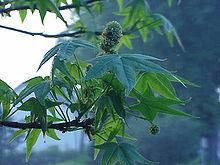| Altingiaceae | |
|---|---|

| |
| Liquidambar styraciflua | |
|
Scientific classification
| |
| Kingdom: | Plantae |
| Clade: | Tracheophytes |
| Clade: | Angiosperms |
| Clade: | Eudicots |
| Order: | Saxifragales |
| Family: |
Altingiaceae Lindl. |
| Genera | |
| |

| |
| The range of Altingiaceae. | |
Altingiaceae is a small family of flowering plants in the order Saxifragales, [1] consisting of wind-pollinated trees that produce hard, woody fruits containing numerous seeds. The fruits have been studied in considerable detail. [2] [3] They naturally occur in Central America, Mexico, eastern North America, the eastern Mediterranean, China, and tropical Asia. [4] They are often cultivated as ornamentals and many produce valuable wood. [5]
Classification
Altingiaceae now consists of the single genus Liquidambar with 15 known species. [6] Previously, the genera Altingia and Semiliquidambar were also recognised, but these represent a rapid radiation and have been difficult to separate reliably. Semiliquidambar has recently been shown to be composed of hybrids of species of Altingia and Liquidambar. This result had been expected for some time. [5] Altingia and Liquidambar are known to be paraphyletic and a revision of the family has been prepared. [4] [7] Many of the species are closely related, and distinctions between them are likely to be artificial. [4]
History
The name "Altingiaceae" has a long and complex taxonomic history. Some attribute the name to John Lindley, who published it in 1846. Others say that the authority for the name is Paul F. Horaninov, who described the group in 1841. [8] In the nineteenth and twentieth centuries, the family Altingiaceae was not generally accepted. Most authors placed these genera in Hamamelidaceae and this treatment has been followed in some recent works as well. [9] In the twenty-first century, however, molecular phylogenetic studies have shown that including Altingiaceae in Hamamelidaceae makes Hamamelidaceae paraphyletic. The Angiosperm Phylogeny Group recognizes four families in the lineage including Altingiaceae. Cercidiphyllaceae and Daphniphyllaceae are sister. This clade is sister to Hamamelidaceae and these three families are sister to Altingiaceae. The clade is sister to Paeoniaceae [10]
The family is named for the genus Altingia, now a synonym of Liquidambar. This genus was named in honor of Willem Arnold Alting (1724–1800), the Governor-General of the Dutch East Indies when Noronha visited Java. [11]
Evolution
Altingiaceae have an extensive fossil record. [12] [13] [14] For most of the Paleogene and Neogene, they were more widely distributed than they are today. The stem group Altingiaceae diverged from the clade [Hamamelidaceae + (Cercidiphyllaceae + Daphniphyllaceae)] in the Turonian stage of the Cretaceous Period, about 90 mya (million years ago). The crown group Altingiaceae is much more recent, originating in the Eocene, about 40 Mya. [4]
References
- ^ Peter F. Stevens (2001 onwards). "Altingiaceae". At: Angiosperm Phylogeny Website. At: Missouri Botanical Garden Website. (see External links below)
- ^ Stephanie M. Ickert-Bond, Kathleen B. Pigg, and Jun Wen. 2005. "Comparative infructescence morphology in Liquidambar (Altingiaceae) and its evolutionary significance". American Journal of Botany 92(8):1234-1255.
- ^ Stephanie M. Ickert-Bond, Kathleen B. Pigg, and Jun Wen. 2007. "Comparative infructescence morphology in Altingia (Altingiaceae) and discordance between morphological and molecular phylogenies". American Journal of Botany 94(7):1094-1115.
- ^ a b c d Stephanie M. Ickert-Bond and Jun Wen. 2006. "Phylogeny and biogeography of Altingiaceae: Evidence from combined analysis of five non-coding chloroplast regions". Molecular Phylogenetics and Evolution 39(2):512-528. (see External links below).
- ^ a b Peter K. Endress. 1993. "Hamamelidaceae". pages 322–331. In: Klaus Kubitzki (editor); Jens G. Rohwer and Volker Bittrich (volume editors). The Families and Genera of Vascular Plants volume II. Springer-Verlag: Berlin;Heidelberg, Germany.
- ^ Christenhusz, M. J. M. & Byng, J. W. (2016). "The number of known plants species in the world and its annual increase". Phytotaxa. 261 (3). Magnolia Press: 201–217. doi: 10.11646/phytotaxa.261.3.1.
- ^ Ickert-Bond & Wen 2013.
- ^ James L. Reveal. 2008 onward. "A Checklist of Family and Suprafamilial Names for Extant Vascular Plants." At: Home page of James L. Reveal and C. Rose Broome. (see External links below).
- ^ Vernon H. Heywood, Richard K. Brummitt, Ole Seberg, and Alastair Culham. Flowering Plant Families of the World. Firefly Books: Ontario, Canada. (2007).
- ^ Shuguang Jian, Pamela S. Soltis, Matthew A. Gitzendanner, Michael J. Moore, Ruiqi Li, Tory A. Hendry, Yin-Long Qiu, Amit Dhingra, Charles D. Bell, and Douglas E. Soltis. 2008. "Resolving an Ancient, Rapid Radiation in Saxifragales". Systematic Biology 57(1):38-57. (see External links below).
- ^ Hayne F. G. 1830: Getreue Darstellung und Beschreibung der in der Arzneykunde gebräuchlichen Gewächse. Vol. 11. Berlin. - Online
- ^ Kathleen B. Pigg, Stephanie M. Ickert-Bond, and Jun Wen. 2004. "Anatomically preserved Liquidambar (Altingiaceae) from the middle Miocene of Yakima Canyon, Washington State, USA, and its biogeographic implications". American Journal of Botany 91(3):499-509.
- ^ Zhe-Kun Zhou, William L. Crepet, and Kevin C. Nixon. 2001. "The earliest fossil evidence of the Hamamelidaceae: Late Cretaceous (Turonian) inflorescences and fruits of Altingioideae". American Journal of Botany 88(5):753-766.
- ^ Patrick S. Herendeen, Susana Magallón-Puebla, Richard Lupia, Peter R. Crane, and Jolanta Kobylinska. 1999. "A preliminary conspectus of the Allon flora from the late Cretaceous (late Santonian) of central Georgia, USA". Annals of the Missouri Botanical Garden 86(2):407-471.
Bibliography
- Ickert-Bond, Stefanie; Wen, Jun (17 December 2013). "A taxonomic synopsis of Altingiaceae with nine new combinations". PhytoKeys (31): 21–61. doi: 10.3897/phytokeys.31.6251. PMC 3881344. PMID 24399902.
- Phylogeny and biogeography of Altingiaceae doi: 10.1016/j.ympev.2005.12.003
- Altingiaceae at Angiosperm Phylogeny Website at Missouri Botanical Garden Website
- Family and Suprafamilial Names at James L. Reveal
- Altingiaceae in L. Watson and M.J. Dallwitz (1992 onwards). The families of flowering plants
- Altingiaceae in BoDD – Botanical Dermatology Database